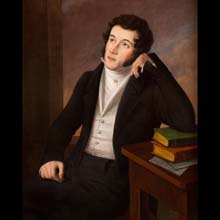
material: oil on canvas
dimensions: 94 x 75 cm
description: It is a portrait of Adam Mickiewicz from the time of his exile in Russia, after the sentence in a trial against the members of the Society of Philomaths and Philarets (1823), a secret, patriotic student organization from Vilnius. The poet met Oleszkiewicz, a painter of allegorical and religious scenes and a talented portraitist, in Saint Petersburg in 1824. The artist, who achieved a high position in Russia working for the imperial court, was a mystic and an important figure in the Masonic movement. He had a great influence on Mickiewicz, arousing his interest in spiritualism, occultism and other esoteric doctrines. The poet, who had already gained renown for, among other things, Ballady i romanse [Ballads and Romances], Grażyna [Grażyna], Sonety krymskie [Sonnets from the Crimea] and Konrad Wallenrod [Konrad Wallenrod] and was famous for his poetical improvisations, began to explain his talents by extraordinary predisposition and direct divine inspiration. The artist portrayed him as a spiritual poet in a dramatized pose, leaning against books, the symbolic attributes of his literary profession, which emphasized his genius, depth of spirit and thought. Mickiewicz immortalized Oleszkiewicz in the third volume of Dziady [Forefathers’ Eve]. Wacława Milewska
exposition: The Gallery of 19th Century Polish Art in Sukiennice,
The Cloth Hall, 1, Main Market Square
key: Romanticism. Towards national art >>>
dimensions: 94 x 75 cm
description: It is a portrait of Adam Mickiewicz from the time of his exile in Russia, after the sentence in a trial against the members of the Society of Philomaths and Philarets (1823), a secret, patriotic student organization from Vilnius. The poet met Oleszkiewicz, a painter of allegorical and religious scenes and a talented portraitist, in Saint Petersburg in 1824. The artist, who achieved a high position in Russia working for the imperial court, was a mystic and an important figure in the Masonic movement. He had a great influence on Mickiewicz, arousing his interest in spiritualism, occultism and other esoteric doctrines. The poet, who had already gained renown for, among other things, Ballady i romanse [Ballads and Romances], Grażyna [Grażyna], Sonety krymskie [Sonnets from the Crimea] and Konrad Wallenrod [Konrad Wallenrod] and was famous for his poetical improvisations, began to explain his talents by extraordinary predisposition and direct divine inspiration. The artist portrayed him as a spiritual poet in a dramatized pose, leaning against books, the symbolic attributes of his literary profession, which emphasized his genius, depth of spirit and thought. Mickiewicz immortalized Oleszkiewicz in the third volume of Dziady [Forefathers’ Eve]. Wacława Milewska
exposition: The Gallery of 19th Century Polish Art in Sukiennice,
The Cloth Hall, 1, Main Market Square
key: Romanticism. Towards national art >>>












